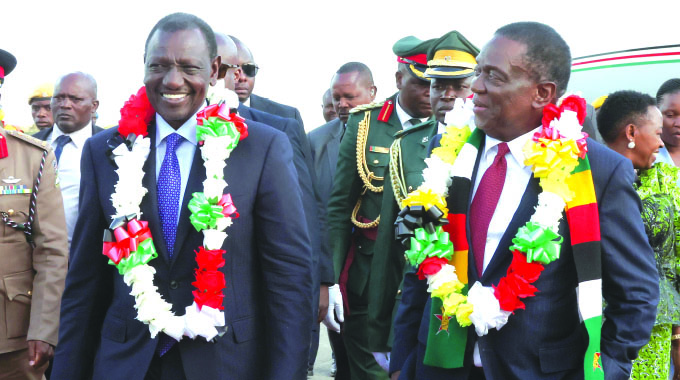Policy interventions save agric sub-sectors

Edgar Vhera
Agriculture Specialist Writer
Government policy interventions under the Second Republic have saved cotton, maize, wheat and livestock enterprises among others from collapsing and plunging rural farmers into the abyss of abject poverty.
With a plethora of problems bedevilling the cotton industry and threatening to hound many farmers out of production, the Government had to act fast. And this required it to address the perceived root cause of the challenges, which was easily traced to the quality and yields.
Cotton merchants had over the years been roundly condemned for short-changing farmers by offering unviable prices, which in reality was true so the Government moved in to address the matter.
This decision saw the Government introducing high-yielding varieties to address both the issues of low yields and the poor quality of lint.
Fast-forward to this year’s cotton season, which saw many of the benefiting farmers coming out with good yields and reaping decent incomes compared to the previous seasons.
The testimony from this year’s best cotton farmer from Nembudziya under Chief Makore in Gokwe district, Mr Smart Kambanje clearly demonstrates how the intervention by the Government has changed the cotton farmers’ fortunes for the better.
“I used to do menial jobs such as weeding in other people’s fields to secure resources to support my own farming activities but now I have managed to build a house and even bought a grind mill.
“In 2018 the Government gave us free cotton input packages, but I planted the open pollinated varieties (OPV) SZ9314 I was used to and only managed 21 bales that fetched very low prices at US$0,34 per kilogramme.
“I changed the cotton seed variety and planted 301 in 2019 and harvested 27 bales but the price was still very low at about $US0,35 per kg. The biggest problem to ruin my cotton yields was too much rains, which pushed me to undertake ridging to draw away excess water from the field and making sure that the cotton plants are on elevated ground,” added Mr Kambanje.
Mr Kambanje again planted another local variety 302 in 2020 and reaped 27 bales once more with the price remaining low again at $47,50 (local currency) per kg.
“In 2021 the Government’s Pfumvudza/Intwasa programme gave me the high yielding Mahyco C567 variety, which I planted on the first of January on one hectare. I managed to get 4 500 kilogrammes of cotton beating all smallholder cotton farmers countrywide in a feat that earned me the gift of a tractor from the President.
Additionally, the Government’s intervention in the pricing of cotton by offering a cash price of US$60 plus $6 500 per 200kg bale this year brought joy to the farming community.
“I managed to get US$2 570 cash and $278 395 in my phone. Apart from cotton, I also planted three hectares of different maize varieties as follows: ZAP 611, ZAP 63 and Shumba SC 69 (one hectare each).
“The maize yielded 12 tonnes, two of which I have already sold to the Grain Marketing Board (GMB) getting US$180 and $200 000.”
Mr Kambanje is committing five hectares to cotton this season. He is encouraging all cotton farmers across the country to adopt good agronomic practices from land preparation, planting, upkeep, harvesting and storage.
He has also challenged cotton farmers to make good use of the free inputs being offered by the Government every year and take farming as a business.
Another beneficiary of the land reform programme on A1 plot, Mrs Maengeni Bingandade of Chigodora Farm in Ward 13 of Mutare district in Manicaland was full of praise for the Government’s Pfumvudza/Intwasa programme, as she scored two tonnes of maize on her one-acre plot last season. This past winter season she planted wheat on slightly less than one hectare and got 1, 75 tonnes, which she has since sold to GMB. Her wheat project was once again under the Government’s Pfumvudza/Intwasa programme for which she received 75kg of seed, five bags of basal fertiliser and a similar quantity for top-dressing.
“My life has changed for the better, as now I make sure that all my six hectares are planted to different crops like groundnuts, roundnuts, as well as traditional grains.
“As we speak, I am at our Pfumvudza input collection point to get maize seed and fertilisers,” said Mrs Bingandade when this news crew talked to her on the phone yesterday.
Under the livestock section, another beneficiary of the Second Republic’s Command Broiler programme is Mr Tafadzwa Charumbura of Goromonzi district in Mashonaland East province.
“I used to do layers but I encountered challenges. My life was changed in 2018 when I benefited from the Command Broiler project when I was given 1 000 broiler chicks with the complete input package for a start. I was given this package for four complete cycles until the project came to an end,” said Mr Charumbira.
“At the end of the programme I was given a recommendation letter to use to get a loan from one of the local banks and moved to do 2 000 broilers at one go. Using my experience from the previous years, I was then incorporated into the EU programme called integrated poultry value chain (IPVC) under the Zimbabwe Agriculture Growth Programme (ZAGP). I have since increased my batch size from 5 000 to 9 000 then the 16 000 that I currently have,” added Mr Charumbira.









Comments